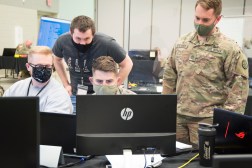
If you’re looking for a view into the future of the Department of Defense’s mobility efforts, look no further than Defense Information Systems Agency Chief Technology Officer David Mihelcic’s interactions with his 12-year-old son.
Mihelcic got his son a computer for Christmas, and he was in his bedroom playing games online with his friends. Mihelcic tried to get his son’s attention first by yelling up to him and then calling his cell phone.
When that failed, Mihelcic – instead of walking upstairs and tapping his boy on the shoulder – pulled out his iPad and downloaded Skype, knowing his son would be on it talking with his friends.
“From start to finish – from downloading the application, to registering for an account, to finding my son in the directory, to getting a voice connection with him – it took all of about four minutes,” Mihelcic said. “That illustrates what we to do in taking down the barriers for entry, allowing that any of our people in any service can get information in anyway at any time.”
Mihelcic said he and his team are involved right now in all of the department’s critical areas of IT, most notably finding efficiencies, agile and collaborative development, virtualization testing, continuous test integration and pinning down the total cost of ownership for big IT systems, not to mention security itself.
He said when it comes to mobility the DOD has been a leader in getting mobile devices in the hands of soldiers and other department employees, but you can never undersell the need to find advances in how to get soldiers information in the most efficient ways possible.
Most notably, Mihelcic said he’d like to use technology that helps the department in a tactical way, pointing to the adoption of the Common Access Card and a program called DOD Visitor and its ability to let military personnel log on to any NIPRNet PC across the globe (and soon SIPRNet, depending on a user’s clearance) as a move in the proper direction.
“It seems simple, but it was a major step for us in showing how mobile can truly go anywhere,” Mihelcic said. “If we can bring enterprise email and enterprise collaboration together in the same way then it can be a powerful combination for us.”






